A Day in the Life of an Air Conditioner Service Professional
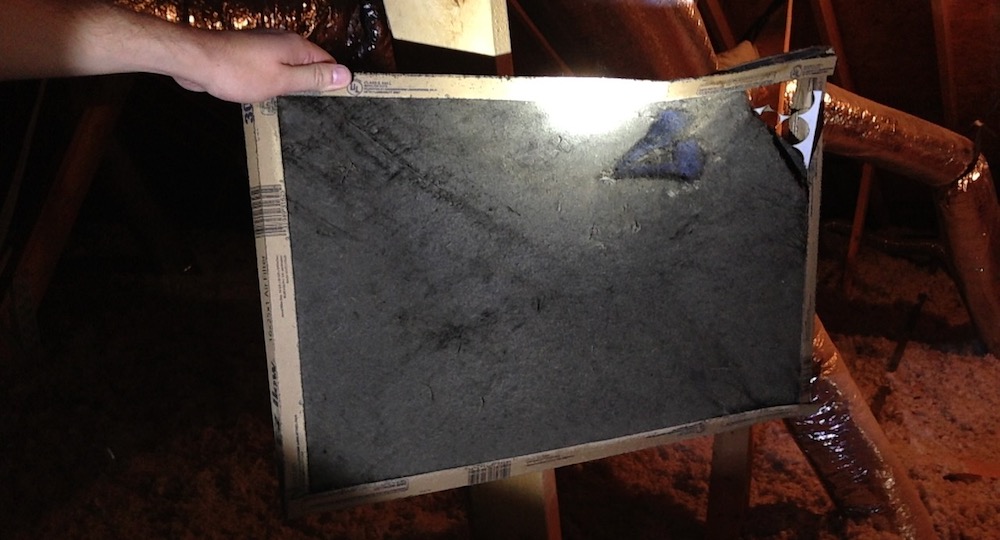
Many of the problems that people experience with cooling their homes are pretty straightforward — simple to fix and often simple to prevent. Of course, there are also bigger problems, like bad insulation, air barriers, and duct installations, but today my focus is (mostly) on the immediate concern of cooling off homeowners whose air conditioners aren’t cooling.
Last week, I spent a day going on calls with Phil Mutz of Moncrief Heating & Air Conditioning. It was a good reminder for me of what it’s like to spend all day responding to homeowners’ air conditioning complaints. As I’ve written in this space before, I spent summers going on calls with my grandfather, who owned an HVAC, electrical, and plumbing company in Leesville, Louisiana. I also spent three years as a home performance contractor, so I know what it’s like to spend time in hot attics…and yet I went out on this 90+ degree F day anyway.
Phil and I went out on 5 calls last Thursday, 4 of them for homeowners with problems keeping their homes cool. Here’s a brief rundown on what we found.
Call #1: No cooling upstairs
This was a fairly new house, probably less than 5 years old. The system had power, so we went straight to the attic and found the dirty filter you see above. The AC hadn’t been cooling at all, so Phil figured that the evaporator coil had frozen up. We replaced the filter and turned it back on. The ice had melted after they turned the system off, so when we turned it back on, it worked.
Well, when I say it worked, I mean that it started blowing cool air again. We know that because we had direct access to the cool air while we were in the attic: A 12″ supply duct was completely disconnected from the supply plenum, as you can see below.
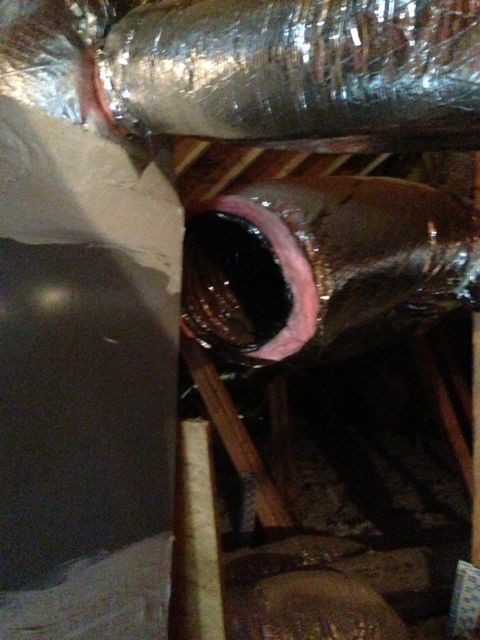
Holy moly! That’s a lot of cool air being lost to the attic. I wonder how long it was like that. When Phil asked about cooling in all of the upstairs rooms, the customer told him that her sister’s room was pretty hot even before the AC went out.
A third problem showed itself when we measured the static pressure. In this system, designed for 0.5″ total external static pressure, we found 0.9″. That means reduced air flow. In this case, as in many, the system is probably oversized for the house and the blower is oversized for the coil, so the reduced air flow is probably about the right amount, sort of. It’s certainly not efficient, though.
Looking around the attic, I saw a fourth problem: a Swiss cheese building enclosure. It had vaulted ceilings, attic kneewalls, and lots of air leakage sites. It had insulation that missed being in contact with the air barrier. And the cable guy screwed things up again, too.
Lessons: (1) Homeowners can keep their AC running by changing the filter. (2) Homeowners can spot disconnected ducts by poking their head in the attic or crawl space. (3) Too many duct systems have air flow problems. (4) You can cool a tent with an air conditioner, but you’ll spend extra money doing so.
Call #2: No cooling anywhere
Three story townhouse, probably less than 10 years old. One zoned system served the first and second floors. Another system served the third floor.
Problem #1: Dirty filter. We were 2 for 2 here. Again, the coil probably had frozen up but melted before we arrived. We checked the refrigerant charge at the condenser, as well as the superheat temperature. After replacing the filter and cleaning the condenser coil, the system worked fine.
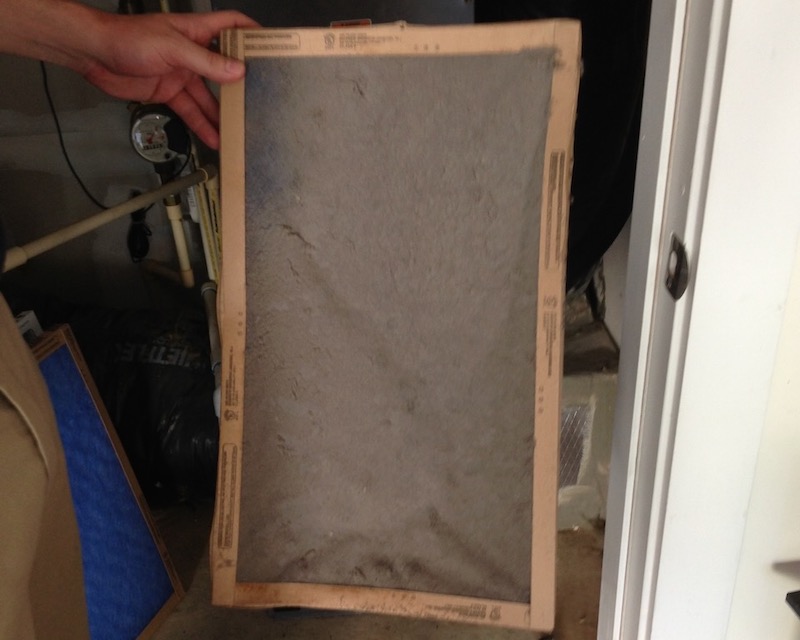
The third floor system wouldn’t come on at all. Phil figured that the capacitor was blown, and indeed it was. When he opened the condenser panel to take a look, the condenser cap was blown outward, the telltale sign that it had “popped.”
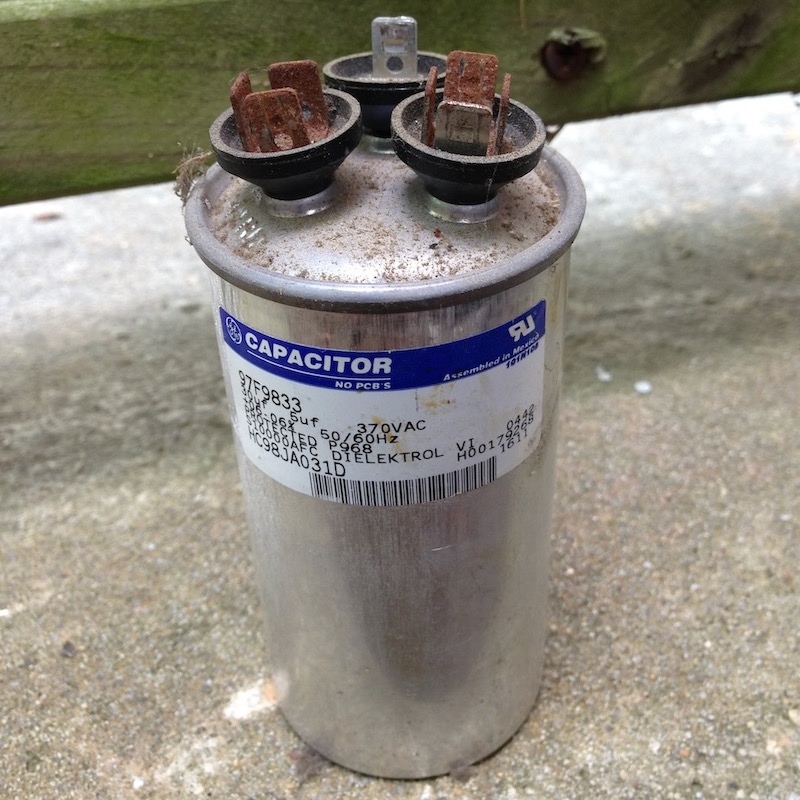
This house also had a pretty bad duct system, but the homeowner couldn’t afford to do anything about it. That would be quite expensive, too, since the first and second floors are served by ducts that are mostly buried behind drywall. Thinking of buying a townhouse? You may well end up with a similar piece of crap.
Lessons: (1) Homeowners should replace the filter regularly. (Have I mentioned that yet?) (2) Capacitors last about 5 to 7 years, according to Phil, so you’re gonna lose your AC sometimes. Even worse, it’s most likely to happen in hotter weather because the AC runs a lot and the capacitor doesn’t have a chance to cool down. (3) Have a knowledgeable pro take a look at the HVAC system if you’re thinking of buying a townhouse.
Call #3: No cooling anywhere
This was one of those cases that’s both really easy and really hard. Their system wasn’t coming on at all. It’s a zoned system. We went into the attic and asked the homeowner to turn it on. And…
Voilà! We fixed it. Well, not really. The system came on and started cooling again. Phil figured there’s some problem with the zone control board that shows up intermittently. Maybe it just needed a reset and will work fine from now on. A more likely possibility is that Moncrief will be back out there trying to track down exactly what’s happening.
Intermittent problems can be very difficult to find and fix. “I don’t like to replace parts unless I catch a problem while it’s happening,” Phil told me.
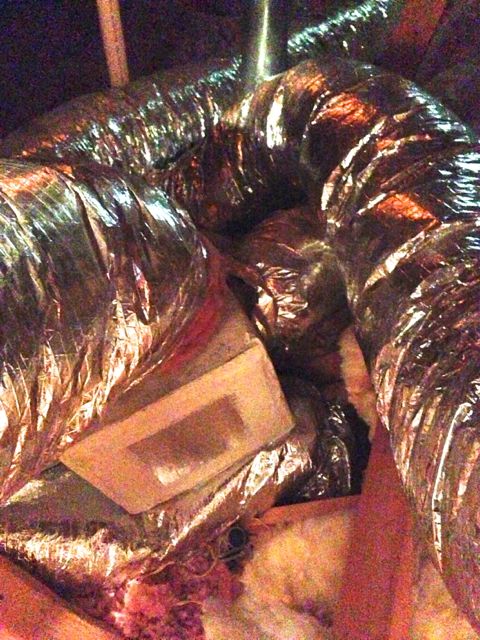
Oh, and again, the duct system was a mess. Lots of flex. Ductboard junction boxes squishing flex ducts. The standard fare.
Lessons: (1) As with computers, rebooting solves some problems. (2) It’s hard to find a house with a good duct system.
Call #4: Water damage on ceiling
This one was different, and the water damage had to do with a bad condensate line. But let’s cut to the chase and go straight to the duct system. The air conditioner we looked at was in the unconditioned attic. We were there in mid-afternoon, so it was HOT up there. I don’t generally sweat a lot but I was sweating that day. Anyway, here’s what we saw:
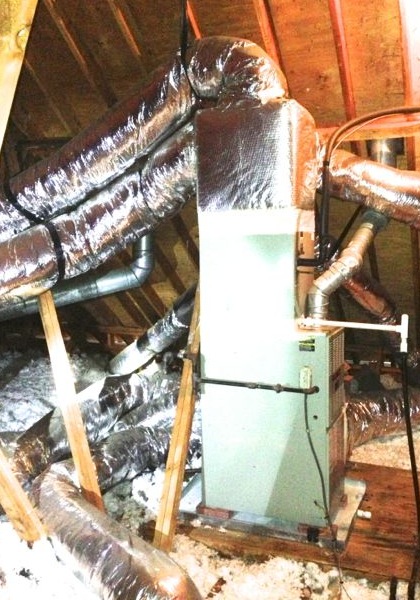
How many problems do you see there? Here’s my short list:
- System and ducts in unconditioned attic
- Supply duct coming straight off of endcap
- Sloppily installed flex ducts with poor support and excess length
Problem #2 means that the duct coming off the top will get more than its fair share of the air. That big turn of ~120° will choke it down a bit, but still, you should never, never put a supply duct right at the end of a plenum or trunkline. (Well, maybe there’s a rare case where it’s OK, but it’s certainly not here.)
Below is another example of how poorly the installers of this system understood air flow. Sharp bends add a lot of resistance!
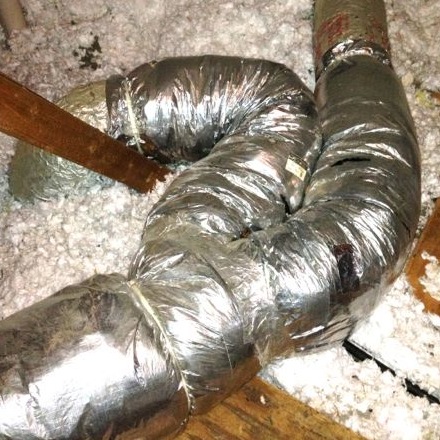
Lesson: No matter what the cooling problem is, it seems that most homes that HVAC companies go into are full of bad duct systems.
Call #5: Cooilng problem upstairs
The homeowners here are in the process of moving into this 50 year old home in Atlanta and have noticed that it’s difficult to cool the upstairs. The closets get very hot and the laundry room gets even hotter. Yes, they have a typically bad duct system, but the bigger issue in this home is heat gain.
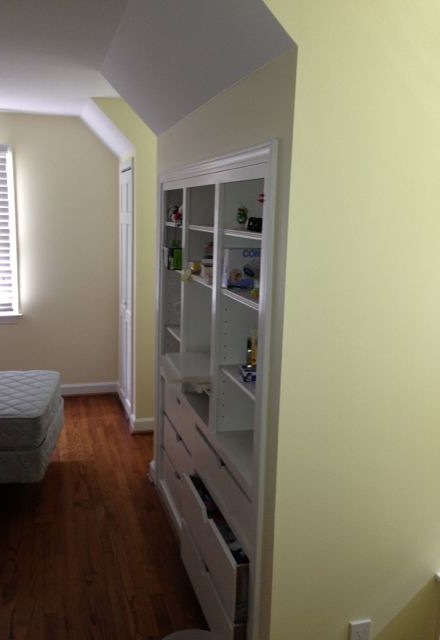
If you’re a home energy pro, you know what the problems are already just from the photo above. This house had 5 dormers on the front, and you can see two of them in the photo above. The attic spaces get very hot. The walls aren’t insulated well—or at all. The vaulted ceiling insulation isn’t doing its job either. Heat pours into the conditioned space.
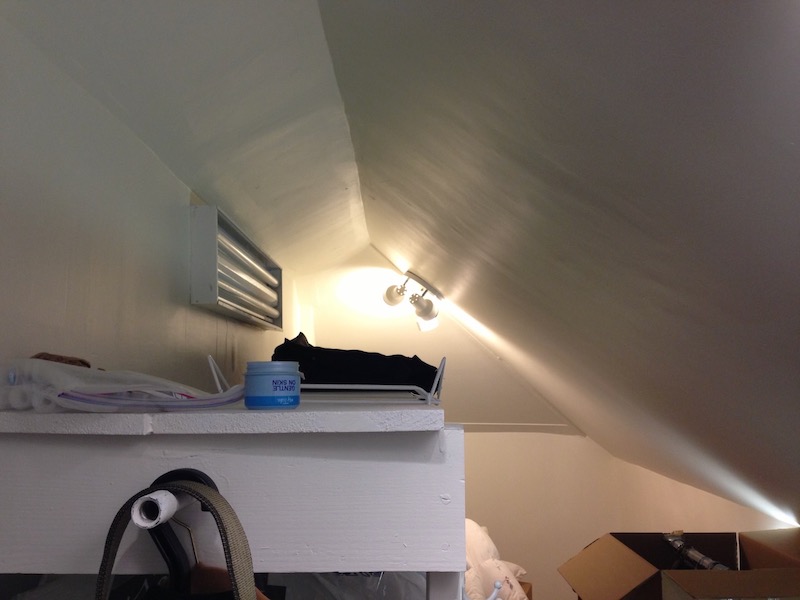
We couldn’t get into the spaces between the dormers to see how well they were insulated, but the laundry room (shown above) on the back side of the house had a scuttle hole. Before even looking into that attic, though, I knew that those innocent looking surfaces you see in the photo were guilty of 1st degree heat gain. I could feel it in the air of the room. I could feel it by how hot the walls and ceilings were. Looking and seeing no insulation on many of the surfaces only confirmed what I already knew.
Lesson: Even with a functional air conditioner, some building enclosure problems are so bad that they really need to be addressed. This is one of those cases.
At the end of the day…
I really hate that expression, but in this case, I did indeed get to the end of the day of my ridealong with Phil of Moncrief Heating & Air. And, at the end of the day, I saw a bit of what HVAC service pros see every day.
When an air conditioner service company gets a “no-cool” call, their immediate concern is to get the AC performing up to its capacity again. Many customers only want that cool air blowing out of the vents again and don’t want to go further. Of course, many of those no-cools are easily preventable by regular maintenance, like changing the filter.
Some customers, however, have the resources and interest in fixing the bigger problems, and that’s why HVAC companies are well suited for home performance work. Once you know about building science, you understand that ‘the box’ is only one component of the heating and cooling system, which also includes the duct system, the building enclosure, and internal heat gains. Then it becomes difficult to go in and just change out a filter or capacitor without also addressing the other problems.
Moncrief has been around since 1898, so they’re used to focusing on the box, like most HVAC companies. In the past decade, though, they’ve begun the transition to putting HVAC in the context of home performance. They’re addressing the duct system problems and regularly measure static pressure, for example, and have been involved with some spray foam jobs to fix faulty building enclosures.
If you’re in the HVAC business and not doing these things, just look at all the business you’re missing out on and all the customers you’re not helping as fully as you could. If you’re a homeowner, keep in mind that your problems with cooling may have other causes. Also, change your filter. Go, do it now. I changed mine today, and I’m embarrassed to admit that it was past due (although not as bad as the two above).
Allison A. Bailes III, PhD is a speaker, writer, building science consultant, and the founder of Energy Vanguard in Decatur, Georgia. He has a doctorate in physics and is the author of a popular book on building science. He also writes the Energy Vanguard Blog. For more updates, you can subscribe to our newsletter and follow him on LinkedIn.
Related Articles
Not All Knowledge Comes from College
Why Won’t the HVAC Industry Do Things Right?
The Magic of Cold, Part 2 – Intermediate Air Conditioning Principles
Comments are closed.
This Post Has 7 Comments
Comments are closed.

A big part of the problem is
A big part of the problem is everything is crammed into the summer months in southern climates, Very little work in the winter, then 8-10 calls per day in summer. Moving home performance work to the cooler times of year when it’s not so hot in the attic and there are less calls to run would help keep everybody working through the winter.
It is amazing how often the
It is amazing how often the only problem is either a) dirty filter, or b) loose/disconnected ducts. B on almost every home (new or old), and A on large percentage.
I once worked on a home w high bills and poor cooling. I asked if they checked filters and changed them regularly. Answer: “Oh yes, usually every month.” So ed looked.
Syst 1: Filter grill was painted to the wall. Painting was done over 1 year ago.
Syst 2: Owner did not think there was a second air return, but there was another filter grill in the upstairs hall (directly at top of stairs). When I pried the filter out, it looked like the ones in your article. There was a ‘Woosh’ and the Owner asked “what’s that noise?” The answer was the house became significantly more quiet! Once the air started flowing, the earlier roar of the A/C went away. The Owners had simply become used to the very loud background noise and thought it was normal.
Problem solved! Recommend check and replace filters each month.
When your suppy takeoffs are
When your suppy takeoffs are well designed/thought out, and when you provide supply dampers for all outlets at the plenum for airflow balancing, locating takeoffs at the end of the plenum for those rooms which have longer distances to travel, and higher airflow needs, works beautifully. We do it all the time with excellent results, and without any problems balancing room airflows to Manual J/D targets. Just thought I’d throw that out there as an example perhaps of the “rare cases” you mentioned, and in response to the bold “never, never” statement. If it were me, I’d use the double never for takeoffs located on the top of plenums in unconditioned attics, especially when anywhere near the roof deck (very common practice here- where we can/should be burying our ducts beneath insulation (dry climate)). But that was also the case for yours- effectively coming off the top of the plenum. 🙂
Looks like you guys had a fun day seeing firsthand that systems running with borderline airflow, due to poor distribution design and installation, are on a razors edge of a service call. How much better to provide a system that is commissioned at 60-75% of manufacturer’s maximum total external static pressure and full airflow, so that there is plenty of wiggle room for the occasional filter change slip up?
Realizing that dirty filters are the cause of many problems with AC, we’ve been installing field adjustable differential pressure sensors which we commission on each system to trigger an alert at the thermostat when the filters must be changed. We’ve found this to be much better than the timed reminders because it won’t go away by a simple button reset (requires an actual filter change to restore the proper pressure), and it keeps filters which don’t require changing yet from entering landfills prematurely.
On Case #4, take a close look
On Case #4, take a close look at that metal drain pan. Does that have a drain outlet which goes nowhere? I really want to know what is professional opinion on this — it was like that in my house too.
@M. Johnson, the code
@M. Johnson, the code requires either a dedicated drain or a float switch as a minimum in attic installations. It’s not a good idea to rely on a dedicated drain because they are usually flat at best and uphill and clogged with insulation more often. Float switches are the best way to avoid a big problem. At this particular home (which is NOT our installation), the customer had a quote to upgrade both primary and secondary drains. In this business, you can only explain the risks and put the ball in their court, but ultimately the customer will make their own decisions.
Bob: What?
Bob: What? You don’t want to spend a lot of time in attics in the summer? Yes, you’re right. If HVAC companies are doing the other work, that’s a perfect way to set up the work schedule.
Geoff H.: Yep. There’s a gazillion stories just like that.
Mike M.: You’re one of the few I would trust doing that and making it work. In this attic, the duct coming off of the trunk was only half the length of the longest run.
M.Johnson: I think they typically don’t drain to anywhere. The little black thing you see on the edge of the left side of that pan is a water sensor with a cutoff switch. I did see a really clever idea for draining that pan on another house recently, though. They ran a pipe to the soffit and had it drain right above a window. That way, if the pan fills, someone might have a chance of seeing the water draining outside their window and then call the HVAC company. (I’ll post a photo of it on our Facebook page in a little while.)
Attempting to make cold air
Attempting to make cold air inside the hottest part of a house is like attempting to break a land speed record with flat tires on the vehicle.
It’s time to stop the insanity and change house design to include mechanicals and air distribution within the thermal boundaries.